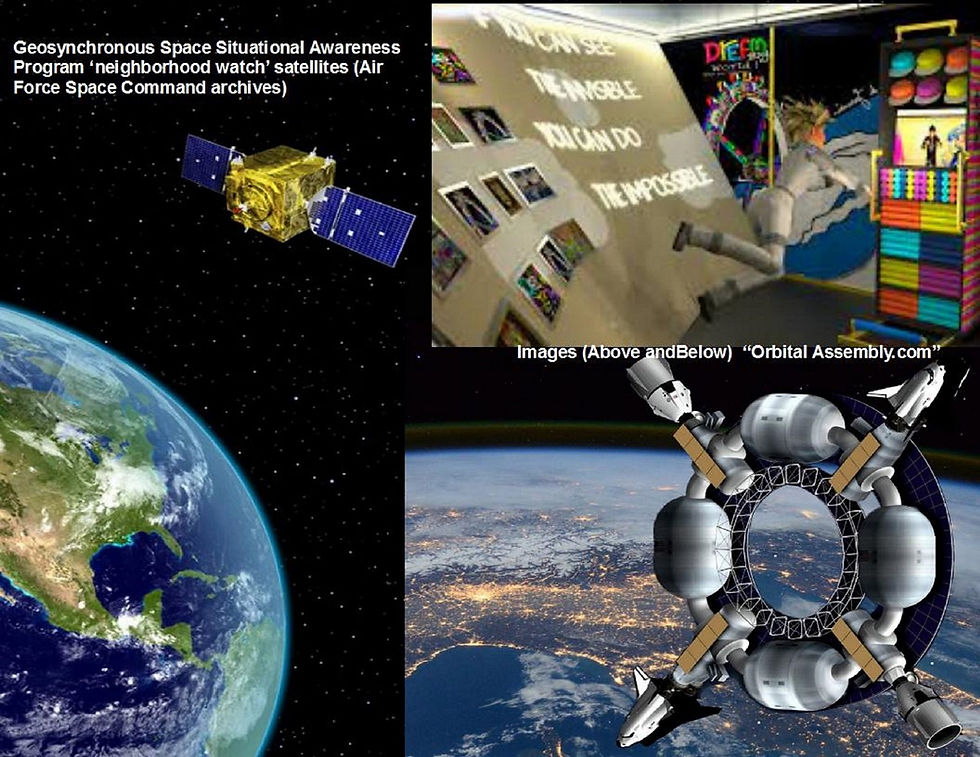Space Force Envisions ‘Freight Trains’ To Space, ‘Walmarts On Orbit’
- Ken Larson

- Mar 3, 2023
- 6 min read

“BREAKING DEFENSE” By Theresa Hitchens
“The Space Force envisions a future where rockets are launched, both to orbit and from one place on Earth to another, almost as frequently as trains carrying cargo leave their stations, according to the service’s lead for space launch acquisition.
“I see Walmarts on orbit” full of cargo, said Col. Meredith Beg, SSC’s deputy director of Operations. “I see Triple A on orbit … Ubers on orbit… full-up service stations on orbit” that might even have Guardians on board to fix up ailing spacecraft.”
________________________________________________________________________________
“We really want to get after that freight train to space. We really want to get to that point where we’re constantly launching,” Maj. Gen. Stephen Purdy, program executive officer at Space Systems Command (SSC) for Assured Access to Space, said Tuesday. “We can’t do that today, but we want to get to that point.”
That vision is at the heart of SSC’s goal in sponsoring the first-ever Space Mobility ’23 conference — with a mix of industry and Defense Department and other government officials, including representatives of regulatory agencies such as the Federal Aviation Administration and the Department of Commerce. Command leaders aim to help forward thinking about how to get from here to there.
SSC’s long-range plans include not just rapid turn-around, or “tactically responsive space” to get things to orbit within hours after identifying a need, but also capabilities like high-speed suborbital point-to-point cargo delivery, and on-orbit refueling, repair and manufacturing, Purdy explained. He even suggested that in the not-so-distant future there could be “on-orbit depots” for storing cargo that could be delivered anywhere on Earth, and space stations housing Guardians to do in-space repairs.
Col. James Horne, Purdy’s deputy, told the conference that assuming current commercial experiments sponsored by Air Force Research Laboratory (AFRL) and US Transportation Command are successful, SSC believes a program of record for cargo delivery via rockets could stand up within a few years.
“The Space Force is the lead service for this program. If any of these different offerings, groups are successful … we’re already starting to activate plans for program stand up in the 2026 timeframe with IOC [initial operational capability] moving to full operational capability as the use cases evolve, and the technology and tools,” he said.
Horne noted that the service sees at least one use case right now for through-space delivery: solving the “tyranny of distance” for operations in the Indo-Pacific theater.
“That presents unique challenges from a mobility perspective. I think applications like Rocket Cargo will really help. So, we are actively engaged with the Secretary of the Air Force [Frank Kendall] on his operational imperatives, we’re talking about some very specific use cases that I wont get into here that these types of capabilities will solve that cannot be solved by ships or airplanes today.”
The idea is for rockets to take off from one earthly launch pad, zip through suborbital space just above the highest reaches of the atmosphere, land again — much like SpaceX now vertically lands its Falcon 9 on a platform at sea.
Mark Surina, of consulting firm LMI that is advising TRANSCOM, noted that while most people think about rockets for delivering large masses of cargo, the command also can see the potential need for smaller, more targeted deliveries at speed.
“I think the spectrum or use cases is going to include cases where we we throw a few hundred pounds or a few tons in some spot that is not only a deployment, but a sustainment [operation such as] medical supplies — something that closes a requirement in a faster time or provides better access than we had before,” he said.
AFRL initiated its Rocket Cargo program as one of its high-priority Vanguard programs in June 2021, partnering with the Space Force and TRANSCOM, and in January 2022 awarded a $102 million contract to SpaceX to explore use of the company’s gigantic Starship to blast cargo through space. TRANSCOM also over the past three years has signed no-cost Cooperative Research And Development Agreements (CRADAs) with SpaceX, BlueOrigin, Sierra Space, Rocket Lab, and Virgin Orbit National Systems.
But whereas Space Force officials pointed to their desire to piggy back on the commercial market for such capabilities, industry representatives speaking on a panel today made it clear that, for the moment, they see the US military as the only viable customer for such services, in large part due to a lack of supporting infrastructure needed to distribute the things rockets can deliver. For example, there will need to be ground locations where rockets can land — needless to say, safely away from populated areas — download their cargo, and to transfer it via road or rail to the end user.
“For it to make commercial sense, we probably need that global network of location,” said Stoke Space CEO Andy Laska. “Probably the the most realistic customer is the DoD in the near term, to start to lay that foundation.”
From Gas Stations To Walmarts, On Orbit
The Space Force’s vision for the future of on-orbit activities from low Earth orbit all the way out to the Moon and beyond is reminiscent of the 1960s cartoon, “The Jetsons” — with robots and people doing everything from re-fueling and repairing satellites to factories cranking out spacecraft parts to orbit-based data crunching centers.
“I see Walmarts on orbit” full of cargo, said Col. Meredith Beg, SSC’s deputy director of Operations, Servicing & Maneuver, a new(ish) position set up last August. “I see Triple A on orbit … Ubers on orbit… full-up service stations on orbit” that might even have Guardians on board to fix up ailing spacecraft, she added.
Stephen “Bucky” Butow, director of space at the Pentagon’s Defense Innovation Unit summed up the end goal for future operations as creating a “blue collar space.”
DIU, AFRL and SSC all have exploratory efforts underway to help kick start technologies related to on-orbit servicing missions, although DoD ultimately is looking to the commercial marketplace for solutions.
Further, Space Command now is broadcasting “a greater demand signal” as to need for on-orbit servicing capabilities to stay in front of the growing threats it sees to US and allied space systems, said Lt. Gen. John Shaw, SPACECOM’s deputy commander.
A key SPACECOM area of interest is on-orbit refueling in order to allow satellites to be move wherever and whenever the need, and do so rapidly, he said. Current satellites — even the Geosynchronous Space Situational Awareness Program (GSSAP) neighborhood watch satellites that were designed to skootch around in geosynchronous orbit to keep eyeballs on potentially nefarious activities of adversary spacecraft — are limited in how often they can move due to the fact that they have a fixed amount of fuel necessary to do so, he explained.
SPACECOM wants “dynamic space operations,” which Shaw told reporters means a set of “missions and platforms that are not Earth-facing and … in order to do their missions best are not necessarily staying static in their orbits. So, GSSAP is the perfect example. We would be operating those much more freely, dynamically, if we could.”
He added that GSSAP isn’t the only reason SPACECOM wants to be able to “maneuver without regret,” noting that “there may be some other capabilities that are coming that are dynamic space operations platforms.” For example, the US military might want to “send a message to somebody else who’s acting in the domain in a way that we don’t like.”
Shaw further noted that SPACECOM sees “better combat capability” coming not just from greater maneuverability on orbit, but also from the resiliency that would be provided by the “commoditization and proliferation” of satellites.
Show Me The Money
While Space Force aspirations seem fairly fleshed out, the big question and obstacle is funding. Because, so far, projects in all these “space mobility and logistics” arenas are at the tech demo or exploration stages. DoD funding — when it actually exists as opposed to no-cost agreements or self-funded industry initiatives — is practically non-existent.
Service officials hint that there may be a few more dollars toward such efforts in fiscal 2024. But one clued-in former government official said Tuesday that even an optimistic date for “real” dollars to start to flow toward these kinds of projects would be FY25.
All those experiments, Beg said, are essentially designed to ensure that once the service actually has the funding, it is ready to take advantage of all the commercial innovation already in the works. She added that in FY23, SSC “did have a small add” to their budget that has helped them start to figure out concepts of operation “and establishing what we need to do.”
But for the foreseeable future, just like “The Jetsons” in its own era, the Space Force’s vision of a rail or air traffic network in space is just that: a vision.”
https://breakingdefense.com/2023/02/space-force-envisions-freight-trains-to-space-walmarts-on-orbit/
ABOUT THE AUTHOR:

Theresa Hitchens is the Space and Air Force reporter at Breaking Defense. The former Defense News editor was a senior research associate at the University of Maryland’s Center for International and Security Studies at Maryland (CISSM). Before that, she spent six years in Geneva, Switzerland as director of the United Nations Institute for Disarmament Research (UNIDIR). A sci-fi geek, voracious reader, enthusiastic cook, dabbler in poetry, Theresa is also the proud mom of a wonderful young man by the name of Nicholas. thitchens@breakingmedia.com
Share this:




Comments